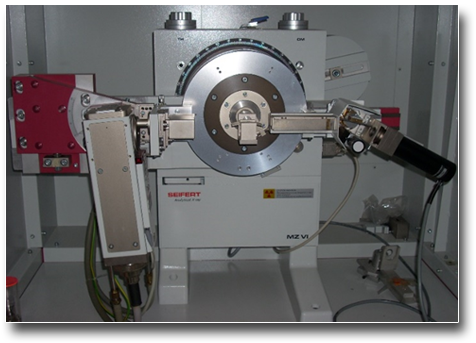Research Activity
The X-ray diffraction laboratory in the ISM headquartes of Montelibretti is equipped with two X-ray diffractometers: Seifert XRD 3003P and Seifert XRD 3003TT. Both use a Cu-Kα radiation (λ = 1.54178 Å). These instruments have a wide range of applications, from the analysis of micro and nanocrystalline powders, to the study of thin films, using x-ray diffraction in normal and grazing incidence. These instruments are of fundamental importance for the growth facilities and the chemical laboratories of the Institute, providing a continuous feedback on the materials (powders and thin films), from the first stages of the synthesis up to the final product. The complete characterization of the synthesis processes and their optimization allow a better understanding of the chemical and physical properties of the materials.
Qualitative and quantitative analysis of the phases present, structural and microstructural analysis (lattice parameters, crystallite sizes, microstrain, textures) is possible. The Rietveld and ab-initio methods are used for the refinement of the structural parameters of known compounds and for the determination of unknown structures.
The scientific activity is focused on the structural study of:
a) magnetic materials, such as FePt films, powders and nanoparticles with the study of cubic and tetragonal structures as a function of various parameters such as temperature, composition and addition of metal additives (e.g. Ag) in the lattice that favor the formation of the tetragonal phase.
Study of metal oxide nanoparticles (hematite, magnetite, akaganeite) as a function of the different reaction conditions.
b) Ag nanoparticles and new Ag nanoclusters coated with different thiolates, interesting for their optical properties (luminescence and plasmonic band), with potential applications in several fields, from medicine (e.g. biolabeling) to microelectronics (e.g. quantum computers).
The structural study covers all phases of the synthesis, from precursors, to thiolate complexes, to coated particles. Depending on the size of the particles, both conventional diffraction techniques and "total scattering" methods have been applied, the latter being more effective in the presence of short-range order.
c) films and powders of hybrid organic-inorganic perovskites of the MAPbX3 type (with MA = CH3NH3 + and X = Cl, Br, I) for photovoltaic applications with the characterization of known structures, after the optimization of the growth parameters.
Instrumentation
Collaborations
- Istituto di Cristallografia


 English (UK)
English (UK)  Italiano (Italia)
Italiano (Italia)